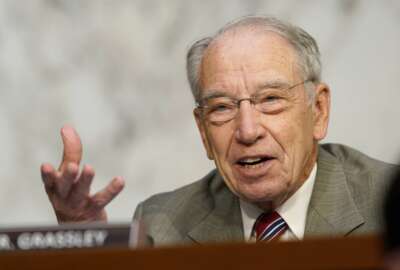Hubbard Radio Washington DC, LLC. All rights reserved. This website is not intended for users located within the European Economic Area.
On Air: Federal News Network
Trending:
‘Best Place to Work?’ — Not so much
The Partnership for Public Service and Deloitte released the 2012 Best Places to Work in Federal Government rankings today. While some agencies improved their e...
wfedstaff | April 17, 2015 4:28 pm
NASA and the Intelligence Community led the pack in employee satisfaction at large agencies in the 2012 edition of The Best Places to Work in the Federal Government, which was released today by The Partnership for Public Service and Deloitte.
While those two agencies may have something to boast about, the annual rankings, which are based on a survey of nearly 700,000 civil servants at 362 agencies and their subcomponents, show an across-the-board decline in employee satisfaction. Governmentwide scores dropped from 64 out of 100 points in 2011 to 60.8 points this year — a 3.2 point decline. That is the greatest change in the annual rankings since the Partnership began publishing them in 2003.
| The Top 10 Best Places to Work – Large Federal Agencies |
| 1. National Aeronautics and Space Administration |
| 2. Intelligence Community |
| 3. Department of State |
| 4. Department of Commerce |
| 5. Environmental Protection Agency |
| 6. Social Security Administration |
| 7. Department of the Treasury |
| 8. Department of Justice |
| 9. Department of Transportation |
| 10. Department of the Navy |
By comparison, employee satisfaction in the private sector has remained constant at 70 points, according to the Partnership’s technical partner, Hay Group.
“The 2012 Best Places to Work results tell a troubling, but not surprising story,” said Max Stier, president and CEO of the Partnership for Public Service in a press release. “Our nation’s public servants have sent a clear signal that all is not well. The two year pay freeze, budget cuts and ad hoc hiring freezes are taking their toll – and this is a red flag.”
To come up with its rankings, the Partnership uses data from the Office of Personnel Management’s Federal Employee Viewpoint Survey. It not only analyzed employee satisfaction in general, but also focused on 10 workplace categories, such as pay, work/life balance, etc., to measure how employees’ felt about their agencies.
Although 66.1 percent of agencies declined in their rankings this year, the survey revealed good news for some, with 32.5 percent of agencies improving their scores and 1.4 percent staying the same.
“What we see across government is a decline, the biggest decline since we’ve been doing the rankings with employee satisfaction and committment with their jobs,” Stier told The Federal Drive with Tom Temin and Emily Kopp Thursday.
Steir said he hoped that the numbers would serve as a wakeup call for policymakers to stop making cuts to the federal workforce and concentrate on pursuing better government by investing in the federal employees.
“What you’re really seeing is in agencies where you have great leadership, leadership that has focused on trying to improve the performance of their organizations by improving the performance of the workforce, engaging their workforce,” Stier said. “You saw increases in those agencies.”
| The Top Five Mid-Size Agencies |
| 1. Federal Deposit Insurance Commission |
| 2. Government Accountability Office |
| 3. Nuclear Regulatory Commission (tie) |
| 3. Smithsonian Institution (tie) |
| 4. Federal Trade Commission |
Agencies had a chance to review the results before the Partnership released its final report. Despite the overall gloomy outlook of the results, Stier said the feedback has been overwhelmingly positive.
“The agencies that are doing better got the kudos that they deserved and need to increase and continue the investments they are making,” he said. “And I think the response from agencies that are doing poorly has largely been a wakeup call recognition that they need to do different things and invest more in their workforce.”
The top five large agencies in the rankings are NASA, the Intelligence Community, the State and Commerce departments and the Environmental Protection Agency. Mid-size agency leaders are the Federal Deposit Insurance Commission, the Government Accountability Office, the Nuclear Regulatory Commission, Smithsonian Institution and the Federal Trade Commission. The top five small agencies are the Surface Transportation Board, Congressional Budget Office, Federal Mediation and Conciliation Service, Peace Corps and the National Endowment of the Humanities.
OPM improved the most of any agency, with a 13.3 point increase. Others that moved in a positive direction included the Department of Transportation, the National Credit Union Administration and the Department of Education’s Office of the Chief Financial Officer. The Army Audit Agency posted the highest score — 85.7 points — out of the 362 ranked agencies.
| The Top Five Small Agencies |
| 1. Surface Transportation Board |
| 2. Congressional Budget Office |
| 3. Federal Mediation and Conciliation Service |
| 4. Peace Corps |
| 5. National Endowment for the Humanities |
“The biggest driver of commitment and employee satisfaction is their sense of their leadership and that starts with their first-line supervisors and goes all the way to the top,” Stier said. “It’s a question of whether the employees feel they are empowered to do their jobs, whether they see line-of-sight between their work and the mission’s organization. These are basic management principles and what we need to see is more attention and focus on creating environments for federal employees where they can do the great jobs that they want to.”
On the downside of the rankings, the Federal Maritime Commission declined the most, dropping 21.9 points. FMC was the most improved small agency in 2009.
Department of Veterans Affairs employees reported the biggest decline in satisfaction for a large agency, going from 63.8 point in 2011 to 56.7 — a 7.1 point drop.
The agency with the lowest score was the Office of the U.S. Trade Representatives, whose employees expressed a 32.7 point level of satisfaction.
Employee satisfaction at National Archives and Records Administration dropped 5.60 points from last year’s survey. Its 2012 ranking of 47.4 put it near the bottom of the rankings for mid-size agencies, with only the Broadcasting Board of Governors posting a lower point total (46.8).
| The Bottom Five Places to Work – Large Federal Agencies |
| 19. Department of Homeland Security |
| 18. Department of Veterans Affairs |
| 16. Department of Labor (tie) |
| 16. Department of Agriculture (tie) |
| 15. Office of the Secretary of Defense, Joint Staff, Defense Agencies, and Department of Defense Field Activities |
“Our employees have a right to personal and professional satisfaction with their work, and in the Archives as a whole,” said David S. Ferriero, archivist of the United States in a statement. “We are a large organization, with a wide spectrum of jobs, and with a broad variety of workplace needs. To meet those needs, our management makes significant effort to listen, to provide for, and to motivate our people.”
Ferriero said his agency was in the middle of a major transformation that involved working with its union, AFGE Council 260, to “identify and execute actions that will have tangible impact on staff satisfaction.”
“This year we are especially focusing on the specific things which NARA staff feels are most important to improve NARA,” he said. “We will continue to explore both cross agency initiatives and specific measures for different organizational units and facilities nationwide.”
While some leaders are doing their job, others aren’t. Recognizing that and making the necessary changes is key for agencies looking to turn low employee satisfaction numbers around.
“The agencies that improved the most are the agencies where, first and foremost, the leadership cared, and they prioritized creating an environment that would engage their employees,” Stier said. “They did this by holding subordinates accountable for focusing on these issues, by making it a priority, by communicating with their employees, by empowering those employees so they actually had the authority to do their jobs effectively and by ensuring they had the right tools and resources.”
But change isn’t all down to the agency leaders. “The policymakers in Congress and elsewhere really need to understand that if we’re going to have government that does more for less, we actually need to invest more in the federal workforce,” Stier said.
|
|
RELATED STORIES
Survey names best places to work in federal government
FDIC, Surface Board rely on communication to take top spots on ‘Best Places to Work’ list
Copyright © 2024 Federal News Network. All rights reserved. This website is not intended for users located within the European Economic Area.
Michael O'Connell
Michael O’Connell is senior digital editor of Federal News Network optimizing content for the best user experience. Follow @moconnellWFED
Follow @moconnellWFED





